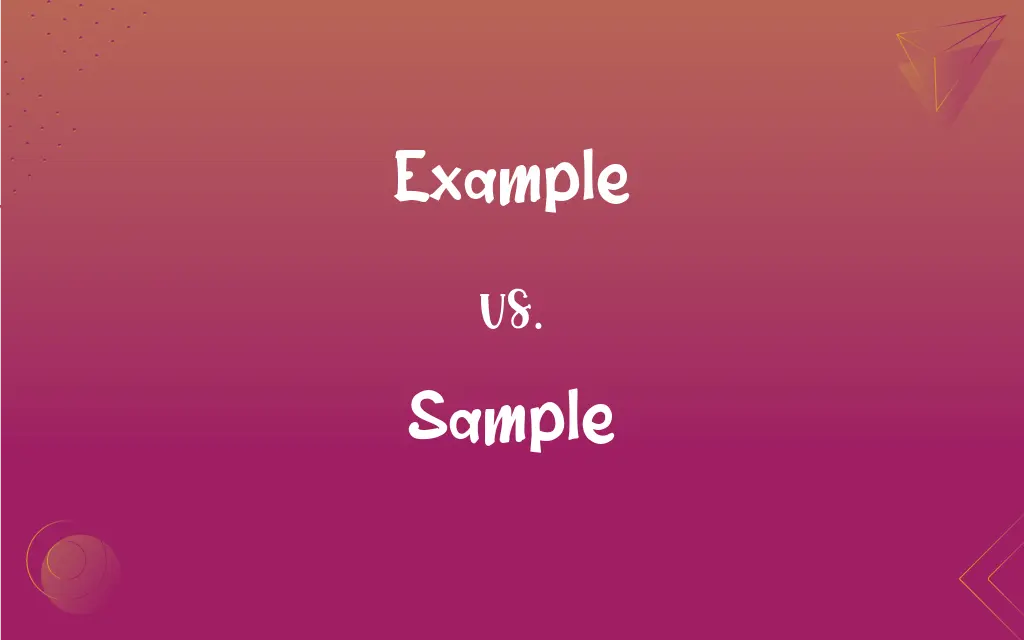Example vs. Sample: What's the Difference?
Edited by Harlon Moss || By Janet White || Published on December 23, 2023
"Example" refers to a representative instance or illustration, while "sample" denotes a small part or subset intended to show what the whole is like.

Key Differences
An example serves as a model or a representative instance, illustrating a concept, rule, or situation. It demonstrates how something is done or provides a pattern to follow. Conversely, a sample is a portion or segment taken from a larger group or whole. Its purpose is to represent the larger entity it comes from, giving insight into the quality, characteristics, or nature of the entire group.
Examples are often found in educational, explanatory, or demonstrative contexts. They are used to simplify and clarify complex ideas, making abstract concepts more accessible. Samples, on the other hand, are used in contexts like scientific research, market analysis, or quality control. They provide a tangible or measurable representation of a larger entity, allowing for analysis, testing, or experimentation.
The primary purpose of an example is to explain, illustrate, or instruct. It acts as a blueprint or guide, showing how something can be done or understood. In contrast, the purpose of a sample is to represent, test, or demonstrate the characteristics of a larger population or product. It serves as a practical tool for assessment or decision-making.
Examples can be specific or general, real or hypothetical, varying in scope depending on their intended use. They are not necessarily part of the content they represent. Samples, however, are always a part of the larger group they come from. They are selected to provide an accurate and representative overview of this larger group, whether it be a product batch, population, or data set.
The nature of examples allows for a wide range of variability; they can be tailored to suit the concept being explained. Their reliability depends on how accurately they represent the rule or principle they illustrate. Samples are expected to be a reliable subset of the whole, with their effectiveness dependent on how accurately they reflect the characteristics of the larger group or entity.
ADVERTISEMENT
Comparison Chart
Purpose
To illustrate or explain a concept or rule
To represent or give a taste of the whole
Context
Educational, instructional
Marketing, scientific, quality control
Nature
Can be hypothetical or real
Always a real subset of a larger entity
Representative Value
May not be part of the content it explains
Always part of the group it represents
Function
For demonstration, instruction
For testing, analysis, experiencing
ADVERTISEMENT
Example and Sample Definitions
Example
A precedent or case used as a reference.
Historical events often serve as an example for modern-day policy decisions.
Sample
A subset of a population used for statistical measurement.
The survey results were based on a sample of the target demographic.
Example
An illustration or instance used for clarification.
The instructor used a simple example to clarify the complex concept.
Sample
A small part or quantity intended to show what the whole is like.
The chef offered a sample of the new dish to the customers.
Example
A person or incident that is typical of or serves as a warning.
The rise and fall of the empire is an example of the consequences of absolute power.
Sample
A piece of a product used for demonstration.
The store provided fabric samples to help customers decide.
Example
An instance serving as a model or pattern.
In mathematics, teachers often use an example to demonstrate a theorem.
Sample
A specimen taken for scientific testing or analysis.
The laboratory tested a sample of the patient's blood.
Example
Something representative of a group or class.
This painting is an excellent example of the Renaissance style.
Sample
A sound or music snippet used in another recording.
The song featured a sample from a famous jazz track.
Example
One that is representative of a group as a whole
The squirrel, an example of a rodent.
Introduced each new word with examples of its use.
Sample
A portion, piece, or segment that is representative of a whole
Showed samples of a new stretch fabric.
Example
One serving as a pattern of a specific kind
Set a good example by arriving on time.
FAQs
Is a sample always a physical object?
No, samples can be abstract, like a sample of data or population.
How is 'sample' different from 'example'?
A sample is a subset of a larger group, used to represent or analyze the whole, while an example is used for illustration or demonstration.
Can an example be fictional?
Yes, examples can be fictional or hypothetical to illustrate a point.
What is an example?
An example is an instance or case used to illustrate or explain a concept or rule.
Can an example be a person?
Yes, a person can be cited as an example to emulate or avoid.
Why are examples used in teaching?
Examples are used in teaching to clarify, demonstrate, and facilitate understanding.
What's the purpose of an example sentence?
An example sentence is used to demonstrate how a word or phrase is used in context.
Is sampling always random?
Not always; sampling can be random or non-random depending on the study's requirements.
Can a sample be biased?
Yes, if not properly selected, samples can be biased and not represent the whole.
How can examples help in problem-solving?
Examples can provide insight and guidance on how to approach and solve similar problems.
How is a sample size determined?
Sample size is determined based on the population size and the precision needed for the study.
Can there be multiple examples for one concept?
Yes, multiple examples can be used to illustrate different aspects of a concept.
How does a sample reflect quality?
A sample reflects quality by representing the features or characteristics of the whole product or group.
Can a sample result be generalized?
Yes, but careful analysis is needed to ensure the sample is representative to generalize results.
Are examples always true?
Not necessarily; examples can be hypothetical or fictional for illustrative purposes.
What is a representative sample?
A representative sample accurately reflects the characteristics of the larger group it's drawn from.
What's the difference between a sample and a survey?
A sample is a subset of a population for analysis, while a survey is a method of collecting data from a sample.
Can examples be misleading?
Yes, if not well chosen, examples can be misleading or misrepresent the concept.
What is a control sample?
A control sample is used in experiments as a standard to compare other samples against.
Are examples necessary in academic writing?
While not always necessary, examples in academic writing help clarify and support arguments.
About Author
Written by
Janet WhiteJanet White has been an esteemed writer and blogger for Difference Wiki. Holding a Master's degree in Science and Medical Journalism from the prestigious Boston University, she has consistently demonstrated her expertise and passion for her field. When she's not immersed in her work, Janet relishes her time exercising, delving into a good book, and cherishing moments with friends and family.
Edited by
Harlon MossHarlon is a seasoned quality moderator and accomplished content writer for Difference Wiki. An alumnus of the prestigious University of California, he earned his degree in Computer Science. Leveraging his academic background, Harlon brings a meticulous and informed perspective to his work, ensuring content accuracy and excellence.






































































